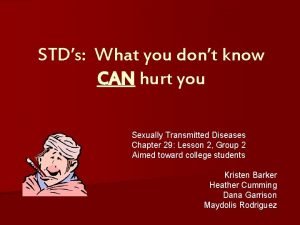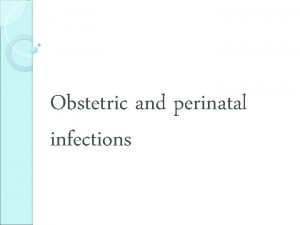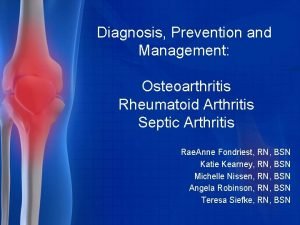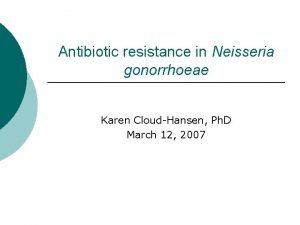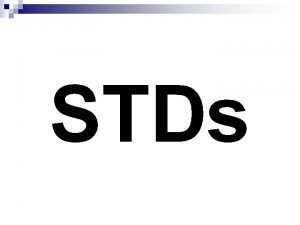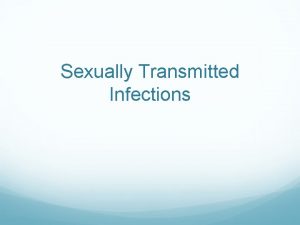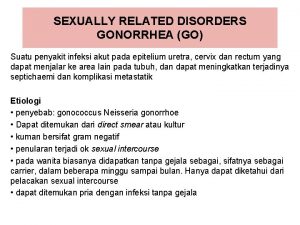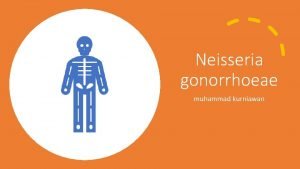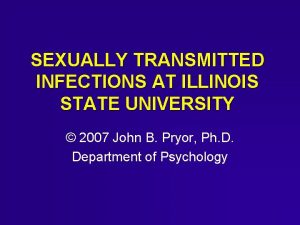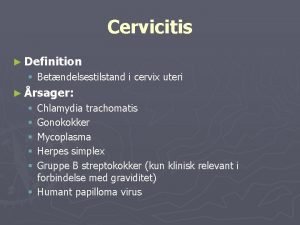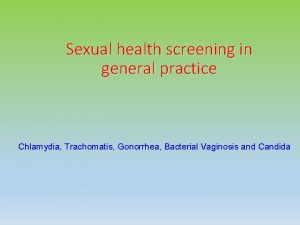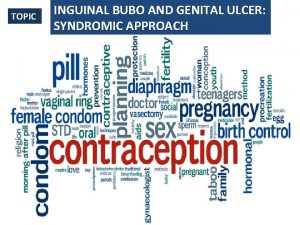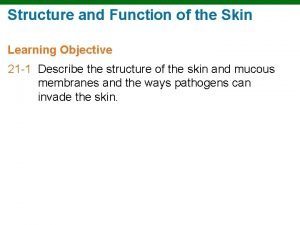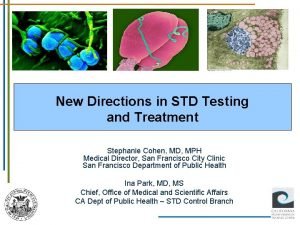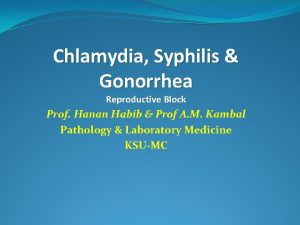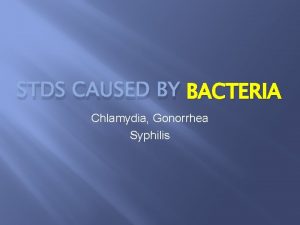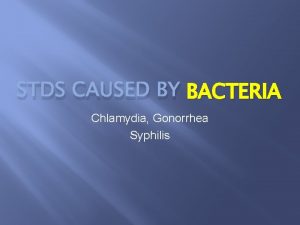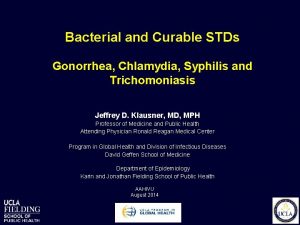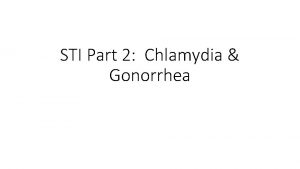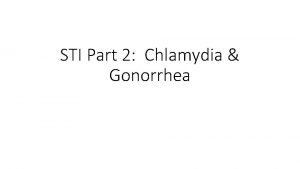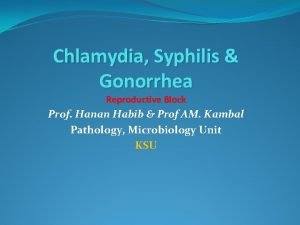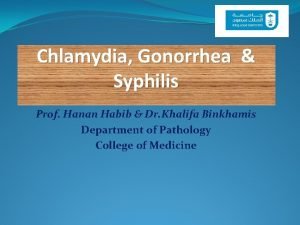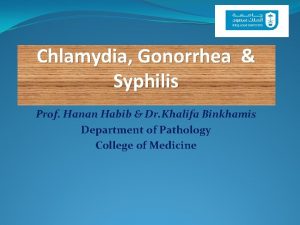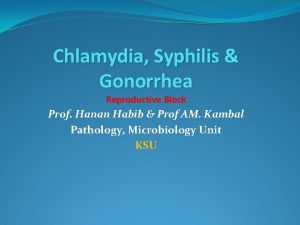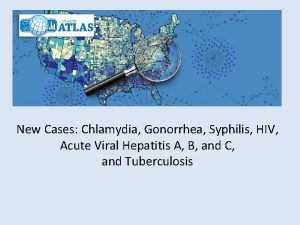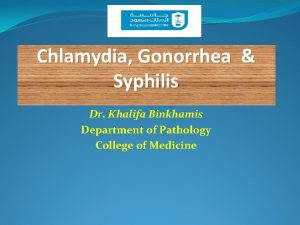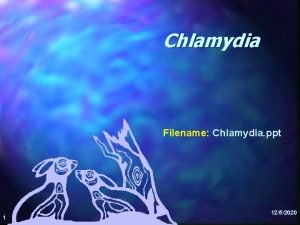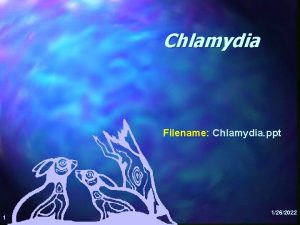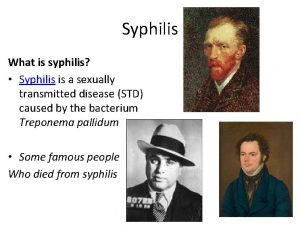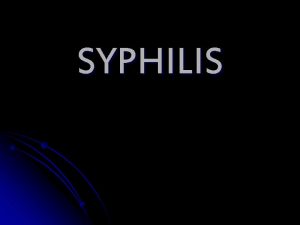Sexual Contact Chlamydia Syphilis and Gonorrhea Katherine Ko






















- Slides: 22

Sexual Contact Chlamydia, Syphilis, and Gonorrhea Katherine Ko Katrina Leong Charity Smith 1

Statistics Chlamydia 2. 86 million/annually (largely unreported) Syphilis 56, 471 cases in 2013 (further division based on reported stages) Gonorrhea 330, 400 cases in 2013 (CDC, 2013) 2

Chlamydia Male Female 3

Syphilis 4

Gonorrhea 5

Similarities ● If caught early, the infections can be cured ● If allowed to progress, physical damage is irreversible ● Infection can be asymptomatic in early stages ● Symptoms may appear mild or harmless ● Transmission: oral, vaginal, and rectal sex o ejaculation does not need to occur to transmit (CDC, 2014) 6

Similarities (cont. ) ● Prevention methods are the same o abstinence, condom use, monogamous relationship where both partners test STD and HIV negative ● Treatment: antibiotics (Z-pac) for pt and partner Abstain from sexual activity until 7 days after antibiotic therapy has begun Increased risk of acquiring HIV (based on sexual behaviors & weakened host resistance) (CDC, 2014) o ● 7

Differences ● Syphilis (S) is “the great imitator” of other infections ○ occurs in 3 stages, can cause perforate hard palate ● Chlamydia (C) & Gonorrhea (G) can lead to PID, but Syphilis does not ● Mode of Transmission: ○ C&G: through vaginal, anal, oral sex ○ S: direct contact with syphilis sores, called chancres (CDC, 2014; Porth, 2011) 8

Differences (cont. ) Transmission from mother to child ● C & G: acquire by passage through birth canal ● S: can pass through placenta Neonatal manifestation of disease ● C: ophthalmia neonatorum (conjunctivitis), pneumonia ● G: blindness, joint infection, blood infection ● S: low birthweight/premature or stillborn Identification: ● S: by blood test ● C & G: Nucleic acid amplification tests (NAATs) - swab/urine (CDC, 2014; Lewis et al. , 2011) 9

Issues of Carrier States More likely to acquire HIV if infected with an STI Incubation: days to weeks Transient: Latent phase (tx with Z-pak): ● Most men and women are asymptomatic o Early symptoms can be mistaken for other conditions o When pregnant mothers are asymptomatic, they can have increased chance having a stillborn child ● Active phase o Physical symptoms appear, for females risk of PID and permanent damage Chronic: Late stage permanent damage Convalescent: Unsafe sex practices lead to inc contraction STDs (CDC, 2014) 10

Roles of PHN ● Be proactive o early education (prevention or counseling) o early prevention (primary or secondary) o early intervention (treatment or follow-up assessment) o always take sexual history! ● Recognize those at risks/high-risk populations ● Encourage yearly testing ● Provide treatment or referrals ● Direct patients to testing facilities or methods ● Build a foundation of trust REMEMBER - Your beliefs should not affect the care you give! (Stanhope & Lancaster, 2014) 11

Client Education/Prevention ● abstinence of oral, anal, vaginal sex ● use of latex condoms ● annual STI testing ● avoid sex with new partners until both have been tested ● avoid sores on genitals ● (parents) teach your children! Education ● SIGNS AND SYMPTOMS ● free testing clinics ● proper treatment plan ● proper condom use (CDC, 2014) 12

Population-Based Surveillance, Prevention, and Control Statistics reveal vulnerable target populations with high incidence of STI’s Surveillance: Locate high risk groups ● Local (i. e. LA County Department of Public Health) and state health departments report STD statistics to CDC ● Hospitals, clinics, labs, STD mobile van, Dont. Think. Know. org ● Other independent info systems: Guardian PH, STD MIS, PRISM, PHIMS-STD, Open Medical Record System, etc. Prevention: Education provided by surveillance outreach programs and health care providers (free condoms provided) Control: Los Angeles County Public Health STD clinics provide free STD, HIV, and AIDS testing, and free STD treatment; PCP: Pay for Performance. (CDC, 2014) 13

Questions for the PHN A patient with a previous history of high risk sexual behavior has been diagnosed with syphilis stage 2. As a public health nurse, you perform: a. Primary prevention b. Secondary prevention c. Tertiary prevention d. No prevention. There’s nothing you can do. 14

Answer c. Tertiary prevention 15

Questions… As a nurse researcher, you noticed that the community of Azusa has a high prevalence of premature and stillborn babies. This could be due to an outbreak of ____. (select all that apply) 1. Gonorrhea 2. Lack of resources for pregnant women 3. Syphilis 4. Chlamydia 16

Answer 3. Syphilis 17

Questions As a nurse clinician, you perform secondary prevention for a pregnant woman who plans to deliver vaginally. You are checking for which STDs? 1. Syphilis and gonorrhea 2. Chlamydia and gonorrhea 3. Chlamydia and syphilis 4. Chlamydia, syphilis and gonorrhea 18

Answer 2. Chlamydia and gonorrhea 19

Questions… 1. You are a nurse clinician, and your patient enters the clinic stating that he is happy that a sore has healed itself. He then shows you a rash that has formed and he just wants skin cream to treat it. Because you know a lot about STI’s, you know that you must rule out ____. a. Chlamydia b. Syphilis c. Gonorrhea 2. You can test for this STI with a ____. a. Blood test b. Urine test c. NAAT swab 20

Answer 1: b. Syphilis 2: a. Blood test 21

References California Pay for Performance Program. (n. d. ). Retrieved March 1, 2015, from http: //www. iha. org/p 4 p_california. html Center of Disease Control. (2014) Chlamydia - CDC Fact Sheet (Detailed). retrieved from: http: //www. cdc. gov/std/chlamydia/stdfact-chlamydia-detailed. htm Center of Disease Control. (2014) Gonorrhea - CDC Fact Sheet (Detailed). retrieved from: http: //www. cdc. gov/std/gonorrhea/STDFact-gonorrhea-detailed. htm Center of Disease Control. (2014) Syphilis - CDC Fact Sheet (Detailed). retrieved from: http: //www. cdc. gov/std/syphilis/stdfact-syphilis. htm Home | Don't Think Know | Dont. Think. Know. org. (n. d. ). Retrieved March 1, 2015, from https: //www. dontthinkknow. org/ Lewis, S. L. , Dirksen, S. R. , Heitkemper, M. M. , Bucher, L. & Camera, I. M. (2011) Medical-surgical nursing: Assessment and management of clinical problems (8 th d. ). St. Louis, MO: Elsevier. Porth, CM. (2011). Essentials of Pathophysiology. Philadelphia, PA: Lippincott Williams & Wilkins. Stanhope M. & Lancaster, J. (2014) Foundations of Nursing in the Community, 4 th Edition, Mosby Elsevier. 22
 Noncontact force examples
Noncontact force examples Which of the following is sliding contact bearing
Which of the following is sliding contact bearing Post encounter stage
Post encounter stage What are some contact forces and some noncontact forces?
What are some contact forces and some noncontact forces? Air resistance contact force
Air resistance contact force Can gonorrhea kill you
Can gonorrhea kill you Gonorrhea ophthalmia neonatorum
Gonorrhea ophthalmia neonatorum Symptoms of gonorrhea
Symptoms of gonorrhea Gonorrhea
Gonorrhea Std from oral
Std from oral Pictures of body lice and scabies
Pictures of body lice and scabies Gonorrhea
Gonorrhea Diplococcus gram negatif
Diplococcus gram negatif Https://www.youtube .com/watch?v=cjmh h67vw6y
Https://www.youtube .com/watch?v=cjmh h67vw6y Gonorrhea
Gonorrhea Trichomoniasis discharge pictures female
Trichomoniasis discharge pictures female Inkubationstid klamydia
Inkubationstid klamydia Grey cloudy discharge
Grey cloudy discharge Std crabs pics
Std crabs pics Chlamydia trachomatis
Chlamydia trachomatis Skinlearning
Skinlearning Syphilis titer chart
Syphilis titer chart Chlamydia trachomatis diagnosis
Chlamydia trachomatis diagnosis





